Management Accounting: Comparing Traditional and ABC Systems
VerifiedAdded on 2021/05/31
|14
|3568
|68
Report
AI Summary
This report provides an executive summary comparing traditional and activity-based costing (ABC) systems, with a focus on their implementation, particularly in the context of Australian businesses. The report delves into both costing systems, highlighting the limitations of traditional methods and the advantages of ABC. It covers cost allocation, the benefits of ABC, and questions to consider when implementing the system. A case study contrasts the two methods, and the report includes a balance scorecard, recommendations, and a conclusion. The introduction establishes the importance of costing systems, while the literature review explores the traditional costing system's inaccuracies and the comprehensive approach of ABC, including its strategic applications like activity-based cost management and budgeting. The report emphasizes the need for efficient cost management and the elimination of non-value-added activities, providing a detailed analysis of costing techniques and their impact on business performance.

qwertyuiopasdfghjklzxcvbnmqwerty
uiopasdfghjklzxcvbnmqwertyuiopasd
fghjklzxcvbnmqwertyuiopasdfghjklzx
cvbnmqwertyuiopasdfghjklzxcvbnmq
wertyuiopasdfghjklzxcvbnmqwertyui
opasdfghjklzxcvbnmqwertyuiopasdfg
hjklzxcvbnmqwertyuiopasdfghjklzxc
vbnmqwertyuiopasdfghjklzxcvbnmq
wertyuiopasdfghjklzxcvbnmqwertyui
opasdfghjklzxcvbnmqwertyuiopasdfg
hjklzxcvbnmqwertyuiopasdfghjklzxc
vbnmqwertyuiopasdfghjklzxcvbnmq
wertyuiopasdfghjklzxcvbnmqwertyui
opasdfghjklzxcvbnmqwertyuiopasdfg
hjklzxcvbnmrtyuiopasdfghjklzxcvbn
mqwertyuiopasdfghjklzxcvbnmqwert
yuiopasdfghjklzxcvbnmqwertyuiopas
MANAGEMENT ACCOUNTING
1
uiopasdfghjklzxcvbnmqwertyuiopasd
fghjklzxcvbnmqwertyuiopasdfghjklzx
cvbnmqwertyuiopasdfghjklzxcvbnmq
wertyuiopasdfghjklzxcvbnmqwertyui
opasdfghjklzxcvbnmqwertyuiopasdfg
hjklzxcvbnmqwertyuiopasdfghjklzxc
vbnmqwertyuiopasdfghjklzxcvbnmq
wertyuiopasdfghjklzxcvbnmqwertyui
opasdfghjklzxcvbnmqwertyuiopasdfg
hjklzxcvbnmqwertyuiopasdfghjklzxc
vbnmqwertyuiopasdfghjklzxcvbnmq
wertyuiopasdfghjklzxcvbnmqwertyui
opasdfghjklzxcvbnmqwertyuiopasdfg
hjklzxcvbnmrtyuiopasdfghjklzxcvbn
mqwertyuiopasdfghjklzxcvbnmqwert
yuiopasdfghjklzxcvbnmqwertyuiopas
MANAGEMENT ACCOUNTING
1
Paraphrase This Document
Need a fresh take? Get an instant paraphrase of this document with our AI Paraphraser

qwertyuiopasdfghjklzxcvbnmqwerty
uiopasdfghjklzxcvbnmqwertyuiopasd
fghjklzxcvbnmqwertyuiopasdfghjklzx
cvbnmqwertyuiopasdfghjklzxcvbnmq
wertyuiopasdfghjklzxcvbnmqwertyui
opasdfghjklzxcvbnmqwertyuiopasdfg
hjklzxcvbnmqwertyuiopasdfghjklzxc
vbnmqwertyuiopasdfghjklzxcvbnmq
wertyuiopasdfghjklzxcvbnmqwertyui
opasdfghjklzxcvbnmqwertyuiopasdfg
hjklzxcvbnmqwertyuiopasdfghjklzxc
vbnmqwertyuiopasdfghjklzxcvbnmq
wertyuiopasdfghjklzxcvbnmqwertyui
opasdfghjklzxcvbnmqwertyuiopasdfg
hjklzxcvbnmrtyuiopasdfghjklzxcvbn
mqwertyuiopasdfghjklzxcvbnmqwert
yuiopasdfghjklzxcvbnmqwertyuiopas
Costing systems
Advanced management accounting
2
uiopasdfghjklzxcvbnmqwertyuiopasd
fghjklzxcvbnmqwertyuiopasdfghjklzx
cvbnmqwertyuiopasdfghjklzxcvbnmq
wertyuiopasdfghjklzxcvbnmqwertyui
opasdfghjklzxcvbnmqwertyuiopasdfg
hjklzxcvbnmqwertyuiopasdfghjklzxc
vbnmqwertyuiopasdfghjklzxcvbnmq
wertyuiopasdfghjklzxcvbnmqwertyui
opasdfghjklzxcvbnmqwertyuiopasdfg
hjklzxcvbnmqwertyuiopasdfghjklzxc
vbnmqwertyuiopasdfghjklzxcvbnmq
wertyuiopasdfghjklzxcvbnmqwertyui
opasdfghjklzxcvbnmqwertyuiopasdfg
hjklzxcvbnmrtyuiopasdfghjklzxcvbn
mqwertyuiopasdfghjklzxcvbnmqwert
yuiopasdfghjklzxcvbnmqwertyuiopas
Costing systems
Advanced management accounting
2

Costing systems
Executive Summary
There has been the huge comparison between the traditional cost system and the modern cost
system that is the activity-based costing when it comes to their implementation. In the case of
Australia, there are many businesses that still use the concept of traditional cost system and such
method has been criticized as they fail to cater to the requirement. In this report, the major
emphasis is on the application of traditional cost system and the ABC. Both the system has been
dealt in an exhaustive manner. Further, the main reason why ABC is treated as an alternative
has been studied. The report sheds light on the Australian business and its approach. Further, the
adoption of ABC is the main highlight of the report.
3
Executive Summary
There has been the huge comparison between the traditional cost system and the modern cost
system that is the activity-based costing when it comes to their implementation. In the case of
Australia, there are many businesses that still use the concept of traditional cost system and such
method has been criticized as they fail to cater to the requirement. In this report, the major
emphasis is on the application of traditional cost system and the ABC. Both the system has been
dealt in an exhaustive manner. Further, the main reason why ABC is treated as an alternative
has been studied. The report sheds light on the Australian business and its approach. Further, the
adoption of ABC is the main highlight of the report.
3
⊘ This is a preview!⊘
Do you want full access?
Subscribe today to unlock all pages.

Trusted by 1+ million students worldwide
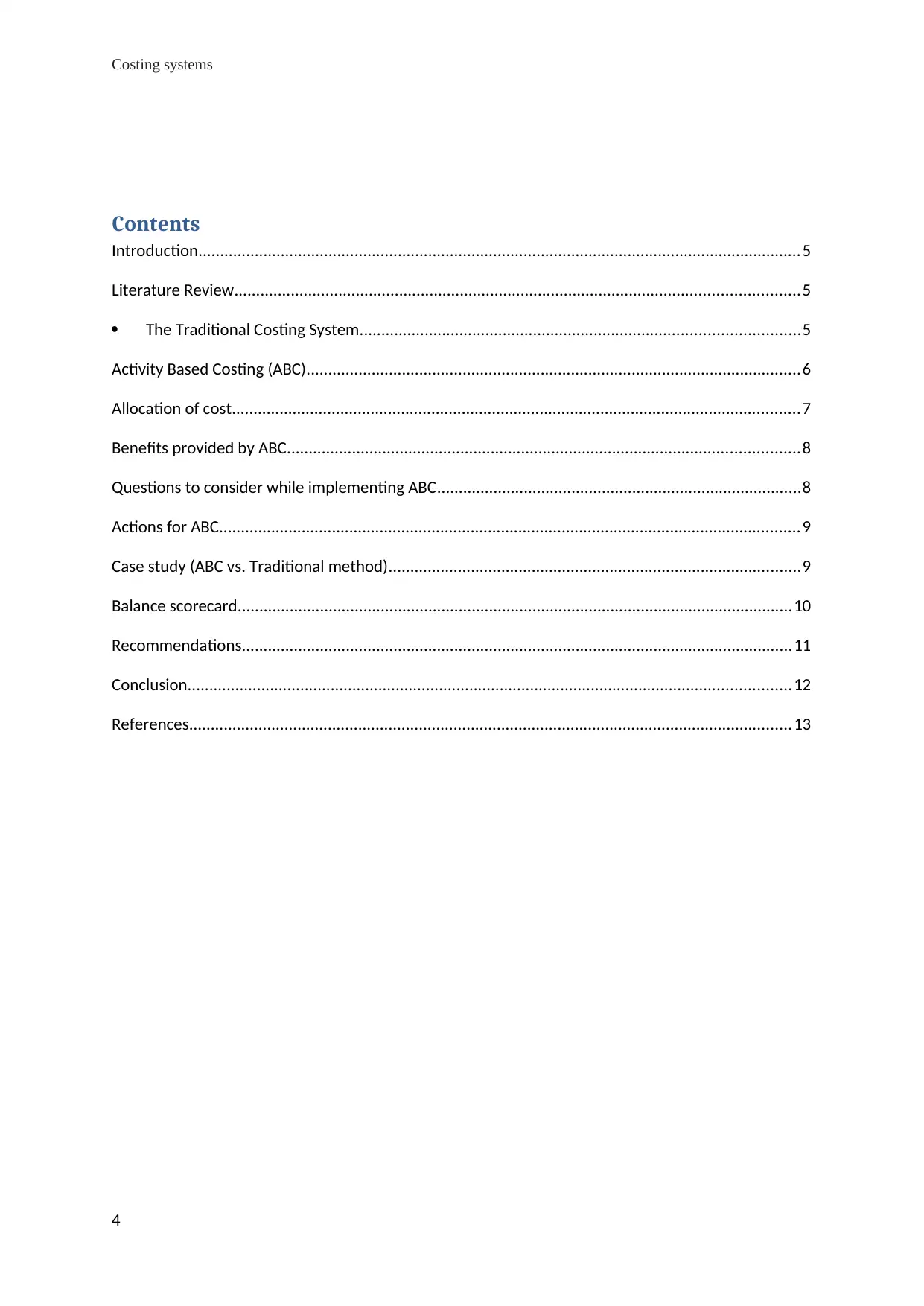
Costing systems
Contents
Introduction...........................................................................................................................................5
Literature Review..................................................................................................................................5
The Traditional Costing System.....................................................................................................5
Activity Based Costing (ABC)..................................................................................................................6
Allocation of cost...................................................................................................................................7
Benefits provided by ABC......................................................................................................................8
Questions to consider while implementing ABC....................................................................................8
Actions for ABC......................................................................................................................................9
Case study (ABC vs. Traditional method)...............................................................................................9
Balance scorecard................................................................................................................................10
Recommendations...............................................................................................................................11
Conclusion...........................................................................................................................................12
References...........................................................................................................................................13
4
Contents
Introduction...........................................................................................................................................5
Literature Review..................................................................................................................................5
The Traditional Costing System.....................................................................................................5
Activity Based Costing (ABC)..................................................................................................................6
Allocation of cost...................................................................................................................................7
Benefits provided by ABC......................................................................................................................8
Questions to consider while implementing ABC....................................................................................8
Actions for ABC......................................................................................................................................9
Case study (ABC vs. Traditional method)...............................................................................................9
Balance scorecard................................................................................................................................10
Recommendations...............................................................................................................................11
Conclusion...........................................................................................................................................12
References...........................................................................................................................................13
4
Paraphrase This Document
Need a fresh take? Get an instant paraphrase of this document with our AI Paraphraser
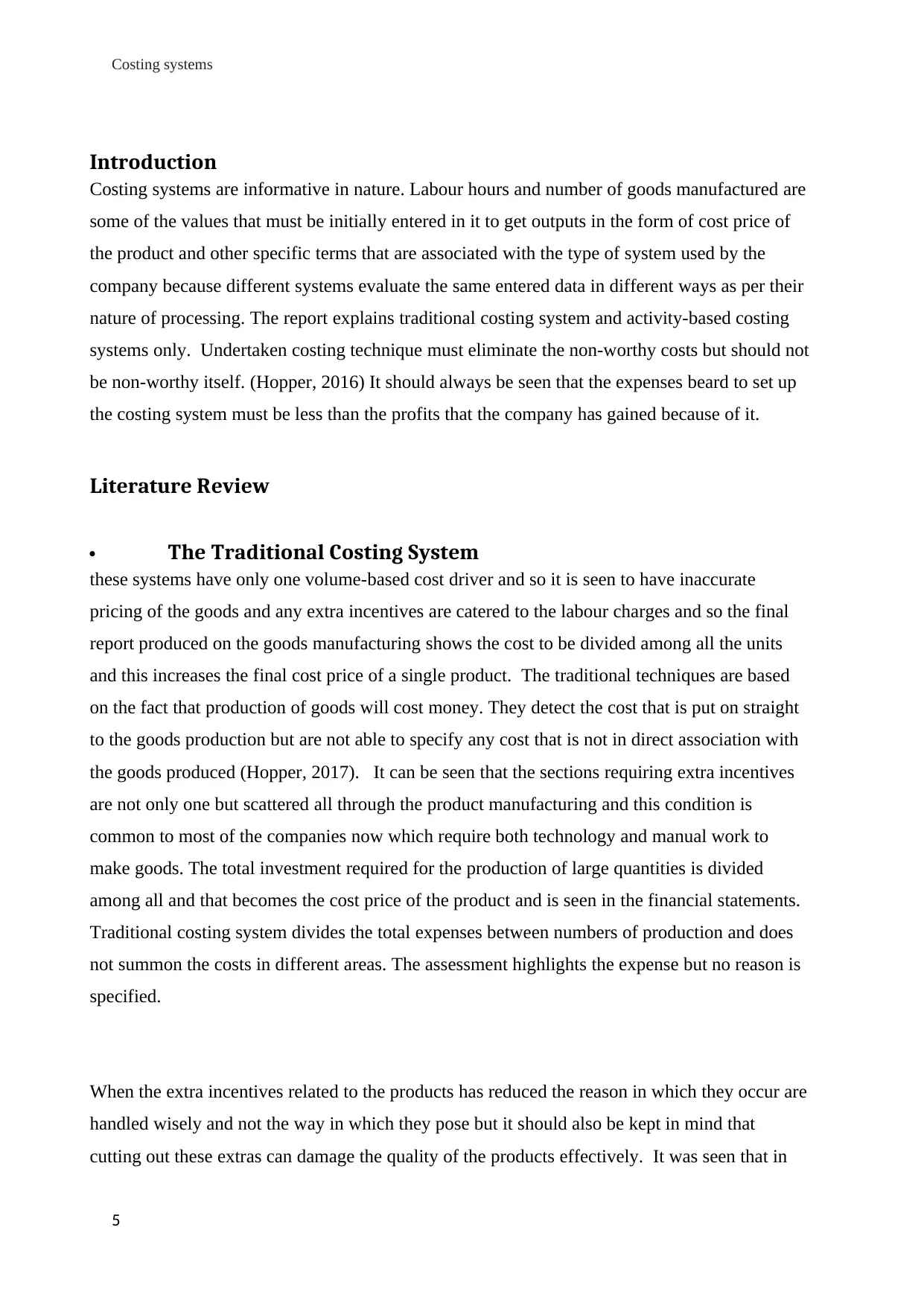
Costing systems
Introduction
Costing systems are informative in nature. Labour hours and number of goods manufactured are
some of the values that must be initially entered in it to get outputs in the form of cost price of
the product and other specific terms that are associated with the type of system used by the
company because different systems evaluate the same entered data in different ways as per their
nature of processing. The report explains traditional costing system and activity-based costing
systems only. Undertaken costing technique must eliminate the non-worthy costs but should not
be non-worthy itself. (Hopper, 2016) It should always be seen that the expenses beard to set up
the costing system must be less than the profits that the company has gained because of it.
Literature Review
The Traditional Costing System
these systems have only one volume-based cost driver and so it is seen to have inaccurate
pricing of the goods and any extra incentives are catered to the labour charges and so the final
report produced on the goods manufacturing shows the cost to be divided among all the units
and this increases the final cost price of a single product. The traditional techniques are based
on the fact that production of goods will cost money. They detect the cost that is put on straight
to the goods production but are not able to specify any cost that is not in direct association with
the goods produced (Hopper, 2017). It can be seen that the sections requiring extra incentives
are not only one but scattered all through the product manufacturing and this condition is
common to most of the companies now which require both technology and manual work to
make goods. The total investment required for the production of large quantities is divided
among all and that becomes the cost price of the product and is seen in the financial statements.
Traditional costing system divides the total expenses between numbers of production and does
not summon the costs in different areas. The assessment highlights the expense but no reason is
specified.
When the extra incentives related to the products has reduced the reason in which they occur are
handled wisely and not the way in which they pose but it should also be kept in mind that
cutting out these extras can damage the quality of the products effectively. It was seen that in
5
Introduction
Costing systems are informative in nature. Labour hours and number of goods manufactured are
some of the values that must be initially entered in it to get outputs in the form of cost price of
the product and other specific terms that are associated with the type of system used by the
company because different systems evaluate the same entered data in different ways as per their
nature of processing. The report explains traditional costing system and activity-based costing
systems only. Undertaken costing technique must eliminate the non-worthy costs but should not
be non-worthy itself. (Hopper, 2016) It should always be seen that the expenses beard to set up
the costing system must be less than the profits that the company has gained because of it.
Literature Review
The Traditional Costing System
these systems have only one volume-based cost driver and so it is seen to have inaccurate
pricing of the goods and any extra incentives are catered to the labour charges and so the final
report produced on the goods manufacturing shows the cost to be divided among all the units
and this increases the final cost price of a single product. The traditional techniques are based
on the fact that production of goods will cost money. They detect the cost that is put on straight
to the goods production but are not able to specify any cost that is not in direct association with
the goods produced (Hopper, 2017). It can be seen that the sections requiring extra incentives
are not only one but scattered all through the product manufacturing and this condition is
common to most of the companies now which require both technology and manual work to
make goods. The total investment required for the production of large quantities is divided
among all and that becomes the cost price of the product and is seen in the financial statements.
Traditional costing system divides the total expenses between numbers of production and does
not summon the costs in different areas. The assessment highlights the expense but no reason is
specified.
When the extra incentives related to the products has reduced the reason in which they occur are
handled wisely and not the way in which they pose but it should also be kept in mind that
cutting out these extras can damage the quality of the products effectively. It was seen that in
5
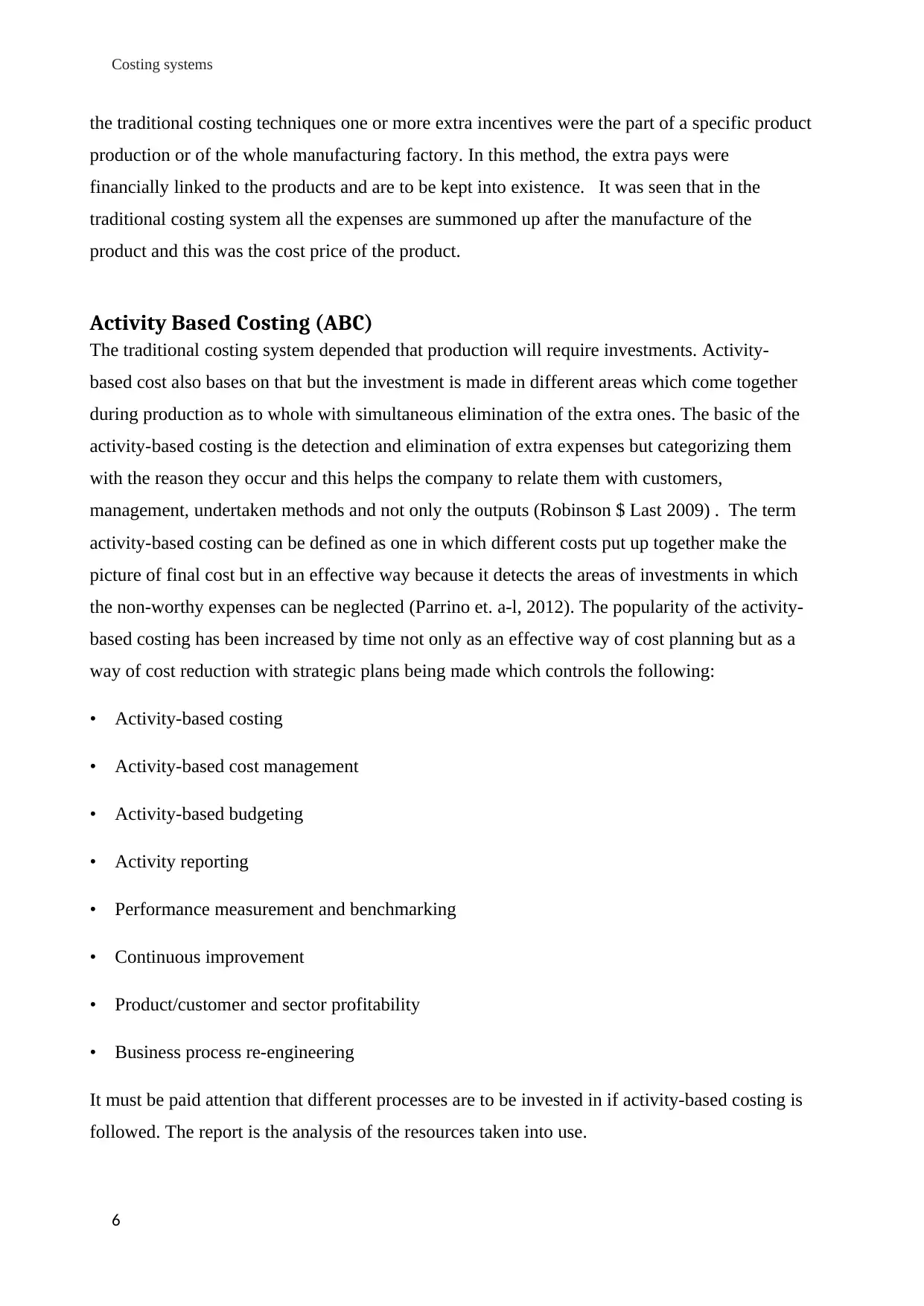
Costing systems
the traditional costing techniques one or more extra incentives were the part of a specific product
production or of the whole manufacturing factory. In this method, the extra pays were
financially linked to the products and are to be kept into existence. It was seen that in the
traditional costing system all the expenses are summoned up after the manufacture of the
product and this was the cost price of the product.
Activity Based Costing (ABC)
The traditional costing system depended that production will require investments. Activity-
based cost also bases on that but the investment is made in different areas which come together
during production as to whole with simultaneous elimination of the extra ones. The basic of the
activity-based costing is the detection and elimination of extra expenses but categorizing them
with the reason they occur and this helps the company to relate them with customers,
management, undertaken methods and not only the outputs (Robinson $ Last 2009) . The term
activity-based costing can be defined as one in which different costs put up together make the
picture of final cost but in an effective way because it detects the areas of investments in which
the non-worthy expenses can be neglected (Parrino et. a-l, 2012). The popularity of the activity-
based costing has been increased by time not only as an effective way of cost planning but as a
way of cost reduction with strategic plans being made which controls the following:
• Activity-based costing
• Activity-based cost management
• Activity-based budgeting
• Activity reporting
• Performance measurement and benchmarking
• Continuous improvement
• Product/customer and sector profitability
• Business process re-engineering
It must be paid attention that different processes are to be invested in if activity-based costing is
followed. The report is the analysis of the resources taken into use.
6
the traditional costing techniques one or more extra incentives were the part of a specific product
production or of the whole manufacturing factory. In this method, the extra pays were
financially linked to the products and are to be kept into existence. It was seen that in the
traditional costing system all the expenses are summoned up after the manufacture of the
product and this was the cost price of the product.
Activity Based Costing (ABC)
The traditional costing system depended that production will require investments. Activity-
based cost also bases on that but the investment is made in different areas which come together
during production as to whole with simultaneous elimination of the extra ones. The basic of the
activity-based costing is the detection and elimination of extra expenses but categorizing them
with the reason they occur and this helps the company to relate them with customers,
management, undertaken methods and not only the outputs (Robinson $ Last 2009) . The term
activity-based costing can be defined as one in which different costs put up together make the
picture of final cost but in an effective way because it detects the areas of investments in which
the non-worthy expenses can be neglected (Parrino et. a-l, 2012). The popularity of the activity-
based costing has been increased by time not only as an effective way of cost planning but as a
way of cost reduction with strategic plans being made which controls the following:
• Activity-based costing
• Activity-based cost management
• Activity-based budgeting
• Activity reporting
• Performance measurement and benchmarking
• Continuous improvement
• Product/customer and sector profitability
• Business process re-engineering
It must be paid attention that different processes are to be invested in if activity-based costing is
followed. The report is the analysis of the resources taken into use.
6
⊘ This is a preview!⊘
Do you want full access?
Subscribe today to unlock all pages.

Trusted by 1+ million students worldwide
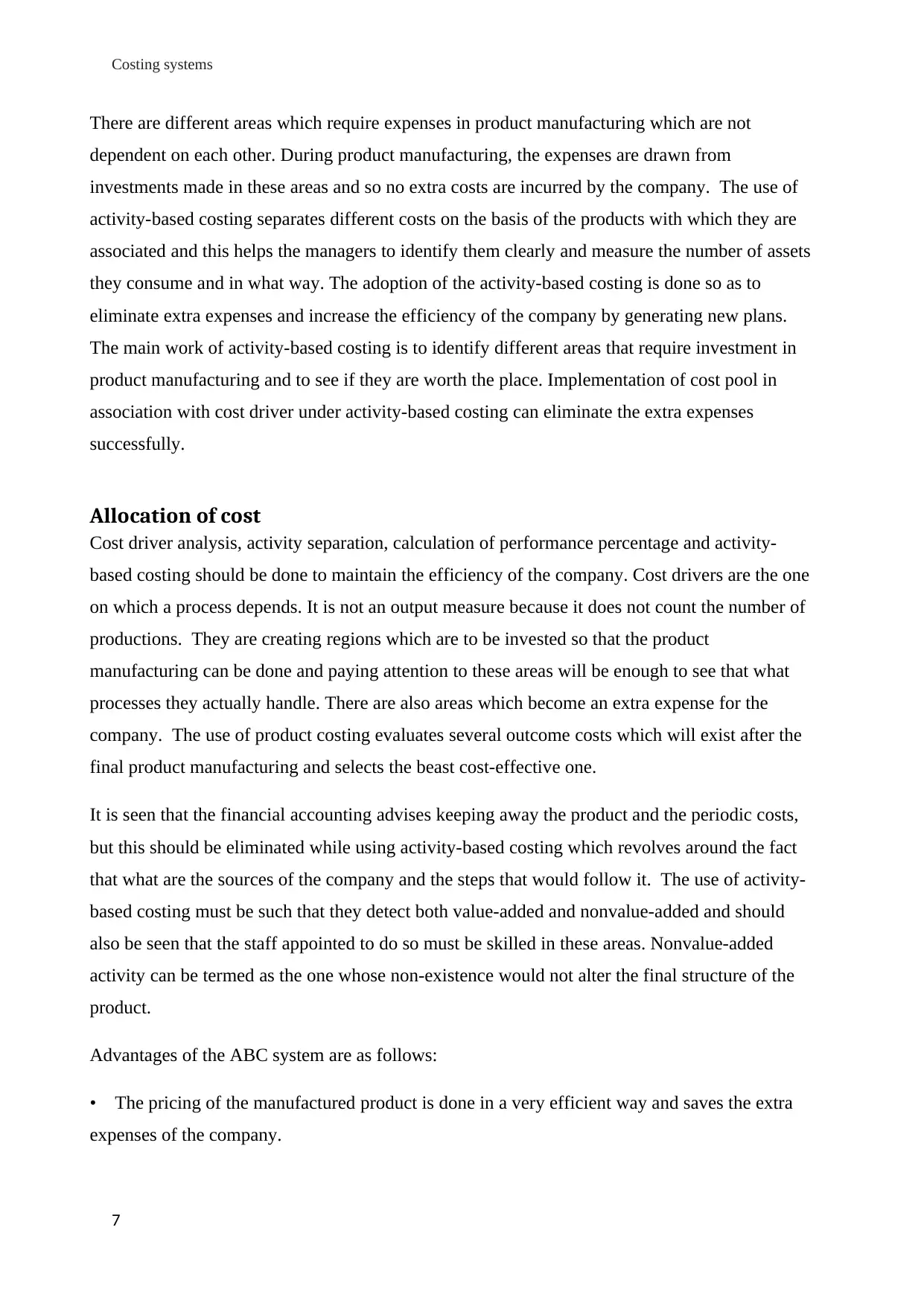
Costing systems
There are different areas which require expenses in product manufacturing which are not
dependent on each other. During product manufacturing, the expenses are drawn from
investments made in these areas and so no extra costs are incurred by the company. The use of
activity-based costing separates different costs on the basis of the products with which they are
associated and this helps the managers to identify them clearly and measure the number of assets
they consume and in what way. The adoption of the activity-based costing is done so as to
eliminate extra expenses and increase the efficiency of the company by generating new plans.
The main work of activity-based costing is to identify different areas that require investment in
product manufacturing and to see if they are worth the place. Implementation of cost pool in
association with cost driver under activity-based costing can eliminate the extra expenses
successfully.
Allocation of cost
Cost driver analysis, activity separation, calculation of performance percentage and activity-
based costing should be done to maintain the efficiency of the company. Cost drivers are the one
on which a process depends. It is not an output measure because it does not count the number of
productions. They are creating regions which are to be invested so that the product
manufacturing can be done and paying attention to these areas will be enough to see that what
processes they actually handle. There are also areas which become an extra expense for the
company. The use of product costing evaluates several outcome costs which will exist after the
final product manufacturing and selects the beast cost-effective one.
It is seen that the financial accounting advises keeping away the product and the periodic costs,
but this should be eliminated while using activity-based costing which revolves around the fact
that what are the sources of the company and the steps that would follow it. The use of activity-
based costing must be such that they detect both value-added and nonvalue-added and should
also be seen that the staff appointed to do so must be skilled in these areas. Nonvalue-added
activity can be termed as the one whose non-existence would not alter the final structure of the
product.
Advantages of the ABC system are as follows:
• The pricing of the manufactured product is done in a very efficient way and saves the extra
expenses of the company.
7
There are different areas which require expenses in product manufacturing which are not
dependent on each other. During product manufacturing, the expenses are drawn from
investments made in these areas and so no extra costs are incurred by the company. The use of
activity-based costing separates different costs on the basis of the products with which they are
associated and this helps the managers to identify them clearly and measure the number of assets
they consume and in what way. The adoption of the activity-based costing is done so as to
eliminate extra expenses and increase the efficiency of the company by generating new plans.
The main work of activity-based costing is to identify different areas that require investment in
product manufacturing and to see if they are worth the place. Implementation of cost pool in
association with cost driver under activity-based costing can eliminate the extra expenses
successfully.
Allocation of cost
Cost driver analysis, activity separation, calculation of performance percentage and activity-
based costing should be done to maintain the efficiency of the company. Cost drivers are the one
on which a process depends. It is not an output measure because it does not count the number of
productions. They are creating regions which are to be invested so that the product
manufacturing can be done and paying attention to these areas will be enough to see that what
processes they actually handle. There are also areas which become an extra expense for the
company. The use of product costing evaluates several outcome costs which will exist after the
final product manufacturing and selects the beast cost-effective one.
It is seen that the financial accounting advises keeping away the product and the periodic costs,
but this should be eliminated while using activity-based costing which revolves around the fact
that what are the sources of the company and the steps that would follow it. The use of activity-
based costing must be such that they detect both value-added and nonvalue-added and should
also be seen that the staff appointed to do so must be skilled in these areas. Nonvalue-added
activity can be termed as the one whose non-existence would not alter the final structure of the
product.
Advantages of the ABC system are as follows:
• The pricing of the manufactured product is done in a very efficient way and saves the extra
expenses of the company.
7
Paraphrase This Document
Need a fresh take? Get an instant paraphrase of this document with our AI Paraphraser
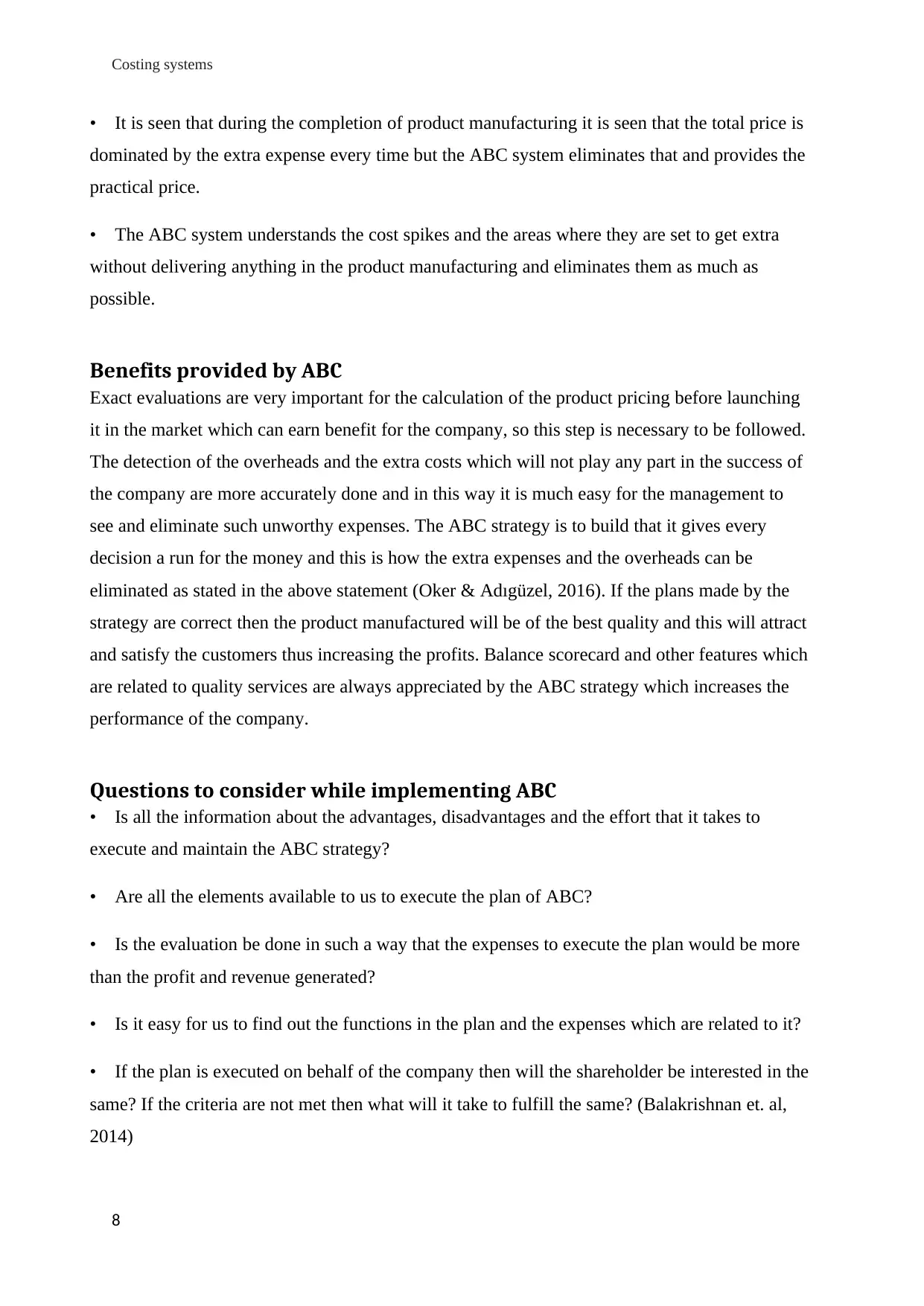
Costing systems
• It is seen that during the completion of product manufacturing it is seen that the total price is
dominated by the extra expense every time but the ABC system eliminates that and provides the
practical price.
• The ABC system understands the cost spikes and the areas where they are set to get extra
without delivering anything in the product manufacturing and eliminates them as much as
possible.
Benefits provided by ABC
Exact evaluations are very important for the calculation of the product pricing before launching
it in the market which can earn benefit for the company, so this step is necessary to be followed.
The detection of the overheads and the extra costs which will not play any part in the success of
the company are more accurately done and in this way it is much easy for the management to
see and eliminate such unworthy expenses. The ABC strategy is to build that it gives every
decision a run for the money and this is how the extra expenses and the overheads can be
eliminated as stated in the above statement (Oker & Adıgüzel, 2016). If the plans made by the
strategy are correct then the product manufactured will be of the best quality and this will attract
and satisfy the customers thus increasing the profits. Balance scorecard and other features which
are related to quality services are always appreciated by the ABC strategy which increases the
performance of the company.
Questions to consider while implementing ABC
• Is all the information about the advantages, disadvantages and the effort that it takes to
execute and maintain the ABC strategy?
• Are all the elements available to us to execute the plan of ABC?
• Is the evaluation be done in such a way that the expenses to execute the plan would be more
than the profit and revenue generated?
• Is it easy for us to find out the functions in the plan and the expenses which are related to it?
• If the plan is executed on behalf of the company then will the shareholder be interested in the
same? If the criteria are not met then what will it take to fulfill the same? (Balakrishnan et. al,
2014)
8
• It is seen that during the completion of product manufacturing it is seen that the total price is
dominated by the extra expense every time but the ABC system eliminates that and provides the
practical price.
• The ABC system understands the cost spikes and the areas where they are set to get extra
without delivering anything in the product manufacturing and eliminates them as much as
possible.
Benefits provided by ABC
Exact evaluations are very important for the calculation of the product pricing before launching
it in the market which can earn benefit for the company, so this step is necessary to be followed.
The detection of the overheads and the extra costs which will not play any part in the success of
the company are more accurately done and in this way it is much easy for the management to
see and eliminate such unworthy expenses. The ABC strategy is to build that it gives every
decision a run for the money and this is how the extra expenses and the overheads can be
eliminated as stated in the above statement (Oker & Adıgüzel, 2016). If the plans made by the
strategy are correct then the product manufactured will be of the best quality and this will attract
and satisfy the customers thus increasing the profits. Balance scorecard and other features which
are related to quality services are always appreciated by the ABC strategy which increases the
performance of the company.
Questions to consider while implementing ABC
• Is all the information about the advantages, disadvantages and the effort that it takes to
execute and maintain the ABC strategy?
• Are all the elements available to us to execute the plan of ABC?
• Is the evaluation be done in such a way that the expenses to execute the plan would be more
than the profit and revenue generated?
• Is it easy for us to find out the functions in the plan and the expenses which are related to it?
• If the plan is executed on behalf of the company then will the shareholder be interested in the
same? If the criteria are not met then what will it take to fulfill the same? (Balakrishnan et. al,
2014)
8

Costing systems
• ABC provides extra supplementary information with which “a-step-ahead” plans can be
made. But will this plan be beneficial for the company?
Actions for ABC
• It is advised to use the ABC plan to the core of the business so that the management can be
benefitted and helped in important decision-making situations.
• It is advised that the use of ABC must be done in order to solve evaluations related to
product pricing (Chapman et. al, 2017).
• It is advised that the execution of the ABC strategy must be carried out by the accountants in
the management as they are much closer and know the functioning of the company so as to
make sure that the new strategy is giving benefit to the company. It should be seen that small
details and every minute element are free to be neglected because they would divert the original
path of the plan that is a big one related to the success of the company. The small expenses can
also be neglected (Hopper et. al, 2015).
• It is not always possible for the ABC plan to deliver something beneficial and the costs
incurred are not always going to turn into profits. Not all costs will disappear if a product is
discontinued, an example being building occupancy costs.
Case study (ABC vs. Traditional method)
The strategy of the ABC was undertaken and executed by the Chinese electrical company Xu Ji
who made it count for their money as they detected the extra costs and expenses which had set
in the business and were not in accordance with the traditional costs in the state-owned
enterprise (SOE). The loopholes which prevailed in the business were successfully removed and
a platform which high level of smooth working was provided to the company. The platform
thing is not an idea in the Chinese market and in the management of the Chinese companies
(Chapman et. al, 2017 ). The ABC planning has been a boon to Xu Ji in their IT department and
also the accounting and ERP implementations.
Before the introduction of the ABC planning in Xu Ji, the company had been operating its
functions as per the traditional business techniques which were seen to include much of the
paperwork manually which was hard to aim at. The company was depending on the financial
9
• ABC provides extra supplementary information with which “a-step-ahead” plans can be
made. But will this plan be beneficial for the company?
Actions for ABC
• It is advised to use the ABC plan to the core of the business so that the management can be
benefitted and helped in important decision-making situations.
• It is advised that the use of ABC must be done in order to solve evaluations related to
product pricing (Chapman et. al, 2017).
• It is advised that the execution of the ABC strategy must be carried out by the accountants in
the management as they are much closer and know the functioning of the company so as to
make sure that the new strategy is giving benefit to the company. It should be seen that small
details and every minute element are free to be neglected because they would divert the original
path of the plan that is a big one related to the success of the company. The small expenses can
also be neglected (Hopper et. al, 2015).
• It is not always possible for the ABC plan to deliver something beneficial and the costs
incurred are not always going to turn into profits. Not all costs will disappear if a product is
discontinued, an example being building occupancy costs.
Case study (ABC vs. Traditional method)
The strategy of the ABC was undertaken and executed by the Chinese electrical company Xu Ji
who made it count for their money as they detected the extra costs and expenses which had set
in the business and were not in accordance with the traditional costs in the state-owned
enterprise (SOE). The loopholes which prevailed in the business were successfully removed and
a platform which high level of smooth working was provided to the company. The platform
thing is not an idea in the Chinese market and in the management of the Chinese companies
(Chapman et. al, 2017 ). The ABC planning has been a boon to Xu Ji in their IT department and
also the accounting and ERP implementations.
Before the introduction of the ABC planning in Xu Ji, the company had been operating its
functions as per the traditional business techniques which were seen to include much of the
paperwork manually which was hard to aim at. The company was depending on the financial
9
⊘ This is a preview!⊘
Do you want full access?
Subscribe today to unlock all pages.

Trusted by 1+ million students worldwide
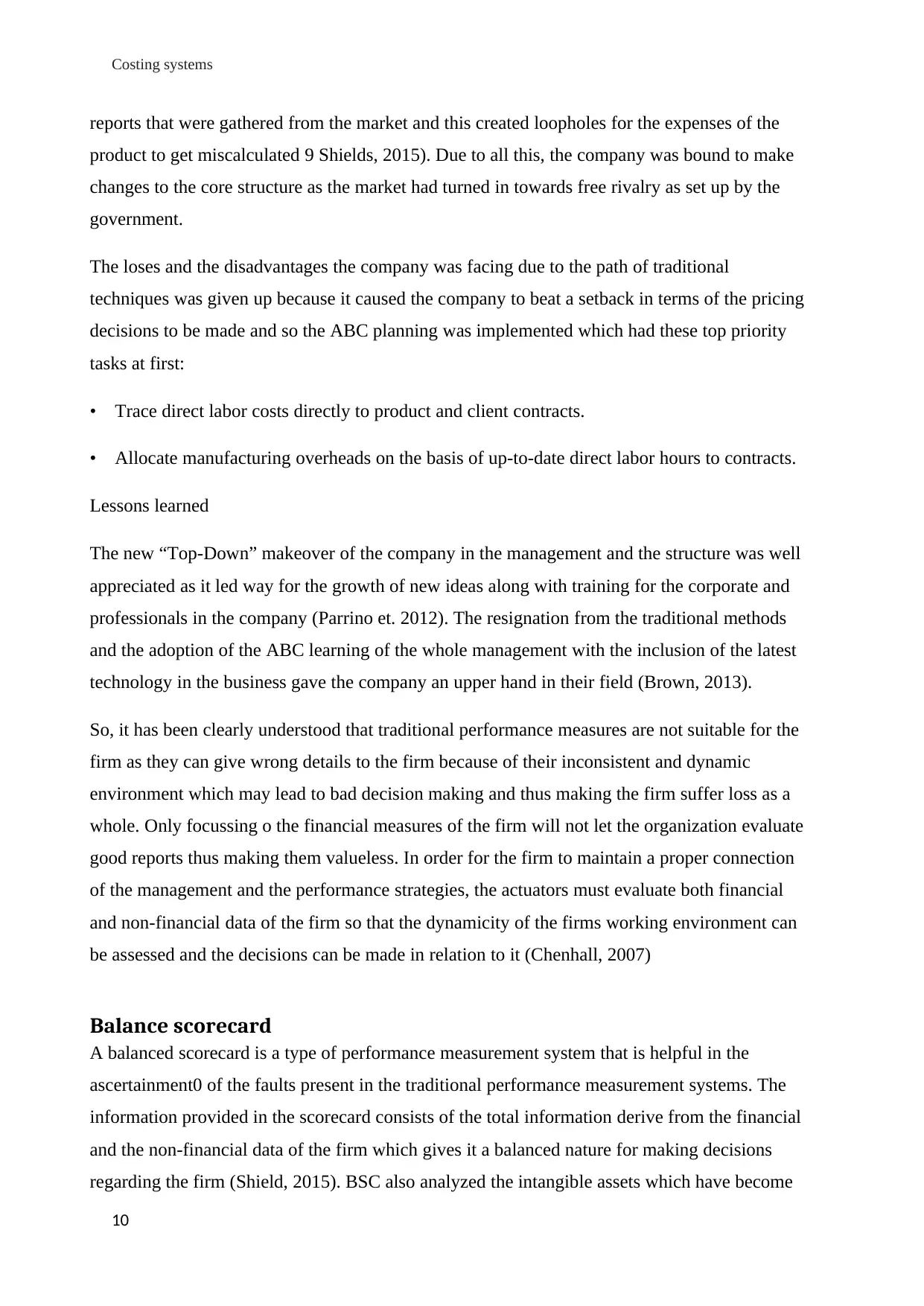
Costing systems
reports that were gathered from the market and this created loopholes for the expenses of the
product to get miscalculated 9 Shields, 2015). Due to all this, the company was bound to make
changes to the core structure as the market had turned in towards free rivalry as set up by the
government.
The loses and the disadvantages the company was facing due to the path of traditional
techniques was given up because it caused the company to beat a setback in terms of the pricing
decisions to be made and so the ABC planning was implemented which had these top priority
tasks at first:
• Trace direct labor costs directly to product and client contracts.
• Allocate manufacturing overheads on the basis of up-to-date direct labor hours to contracts.
Lessons learned
The new “Top-Down” makeover of the company in the management and the structure was well
appreciated as it led way for the growth of new ideas along with training for the corporate and
professionals in the company (Parrino et. 2012). The resignation from the traditional methods
and the adoption of the ABC learning of the whole management with the inclusion of the latest
technology in the business gave the company an upper hand in their field (Brown, 2013).
So, it has been clearly understood that traditional performance measures are not suitable for the
firm as they can give wrong details to the firm because of their inconsistent and dynamic
environment which may lead to bad decision making and thus making the firm suffer loss as a
whole. Only focussing o the financial measures of the firm will not let the organization evaluate
good reports thus making them valueless. In order for the firm to maintain a proper connection
of the management and the performance strategies, the actuators must evaluate both financial
and non-financial data of the firm so that the dynamicity of the firms working environment can
be assessed and the decisions can be made in relation to it (Chenhall, 2007)
Balance scorecard
A balanced scorecard is a type of performance measurement system that is helpful in the
ascertainment0 of the faults present in the traditional performance measurement systems. The
information provided in the scorecard consists of the total information derive from the financial
and the non-financial data of the firm which gives it a balanced nature for making decisions
regarding the firm (Shield, 2015). BSC also analyzed the intangible assets which have become
10
reports that were gathered from the market and this created loopholes for the expenses of the
product to get miscalculated 9 Shields, 2015). Due to all this, the company was bound to make
changes to the core structure as the market had turned in towards free rivalry as set up by the
government.
The loses and the disadvantages the company was facing due to the path of traditional
techniques was given up because it caused the company to beat a setback in terms of the pricing
decisions to be made and so the ABC planning was implemented which had these top priority
tasks at first:
• Trace direct labor costs directly to product and client contracts.
• Allocate manufacturing overheads on the basis of up-to-date direct labor hours to contracts.
Lessons learned
The new “Top-Down” makeover of the company in the management and the structure was well
appreciated as it led way for the growth of new ideas along with training for the corporate and
professionals in the company (Parrino et. 2012). The resignation from the traditional methods
and the adoption of the ABC learning of the whole management with the inclusion of the latest
technology in the business gave the company an upper hand in their field (Brown, 2013).
So, it has been clearly understood that traditional performance measures are not suitable for the
firm as they can give wrong details to the firm because of their inconsistent and dynamic
environment which may lead to bad decision making and thus making the firm suffer loss as a
whole. Only focussing o the financial measures of the firm will not let the organization evaluate
good reports thus making them valueless. In order for the firm to maintain a proper connection
of the management and the performance strategies, the actuators must evaluate both financial
and non-financial data of the firm so that the dynamicity of the firms working environment can
be assessed and the decisions can be made in relation to it (Chenhall, 2007)
Balance scorecard
A balanced scorecard is a type of performance measurement system that is helpful in the
ascertainment0 of the faults present in the traditional performance measurement systems. The
information provided in the scorecard consists of the total information derive from the financial
and the non-financial data of the firm which gives it a balanced nature for making decisions
regarding the firm (Shield, 2015). BSC also analyzed the intangible assets which have become
10
Paraphrase This Document
Need a fresh take? Get an instant paraphrase of this document with our AI Paraphraser
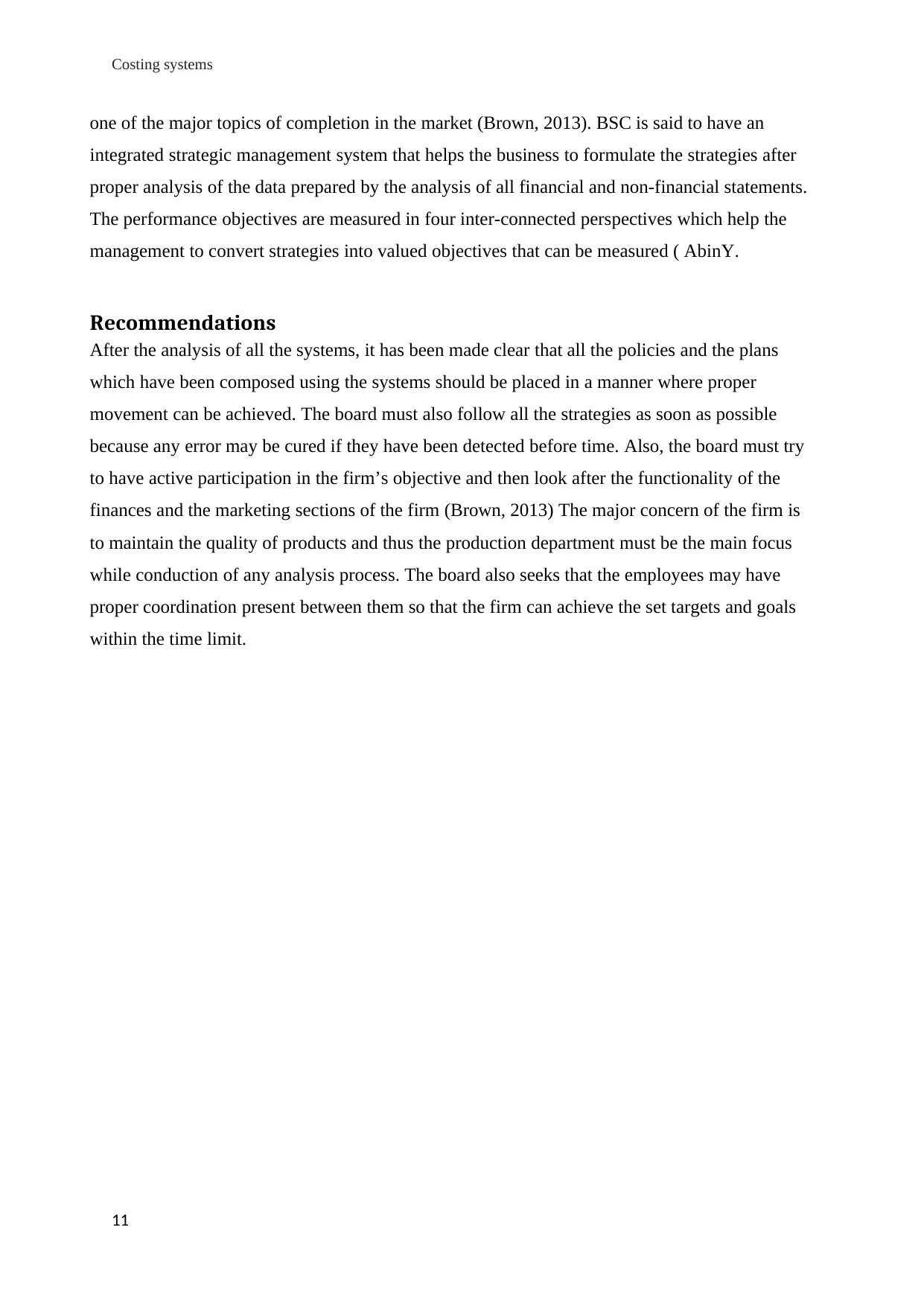
Costing systems
one of the major topics of completion in the market (Brown, 2013). BSC is said to have an
integrated strategic management system that helps the business to formulate the strategies after
proper analysis of the data prepared by the analysis of all financial and non-financial statements.
The performance objectives are measured in four inter-connected perspectives which help the
management to convert strategies into valued objectives that can be measured ( AbinY.
Recommendations
After the analysis of all the systems, it has been made clear that all the policies and the plans
which have been composed using the systems should be placed in a manner where proper
movement can be achieved. The board must also follow all the strategies as soon as possible
because any error may be cured if they have been detected before time. Also, the board must try
to have active participation in the firm’s objective and then look after the functionality of the
finances and the marketing sections of the firm (Brown, 2013) The major concern of the firm is
to maintain the quality of products and thus the production department must be the main focus
while conduction of any analysis process. The board also seeks that the employees may have
proper coordination present between them so that the firm can achieve the set targets and goals
within the time limit.
11
one of the major topics of completion in the market (Brown, 2013). BSC is said to have an
integrated strategic management system that helps the business to formulate the strategies after
proper analysis of the data prepared by the analysis of all financial and non-financial statements.
The performance objectives are measured in four inter-connected perspectives which help the
management to convert strategies into valued objectives that can be measured ( AbinY.
Recommendations
After the analysis of all the systems, it has been made clear that all the policies and the plans
which have been composed using the systems should be placed in a manner where proper
movement can be achieved. The board must also follow all the strategies as soon as possible
because any error may be cured if they have been detected before time. Also, the board must try
to have active participation in the firm’s objective and then look after the functionality of the
finances and the marketing sections of the firm (Brown, 2013) The major concern of the firm is
to maintain the quality of products and thus the production department must be the main focus
while conduction of any analysis process. The board also seeks that the employees may have
proper coordination present between them so that the firm can achieve the set targets and goals
within the time limit.
11
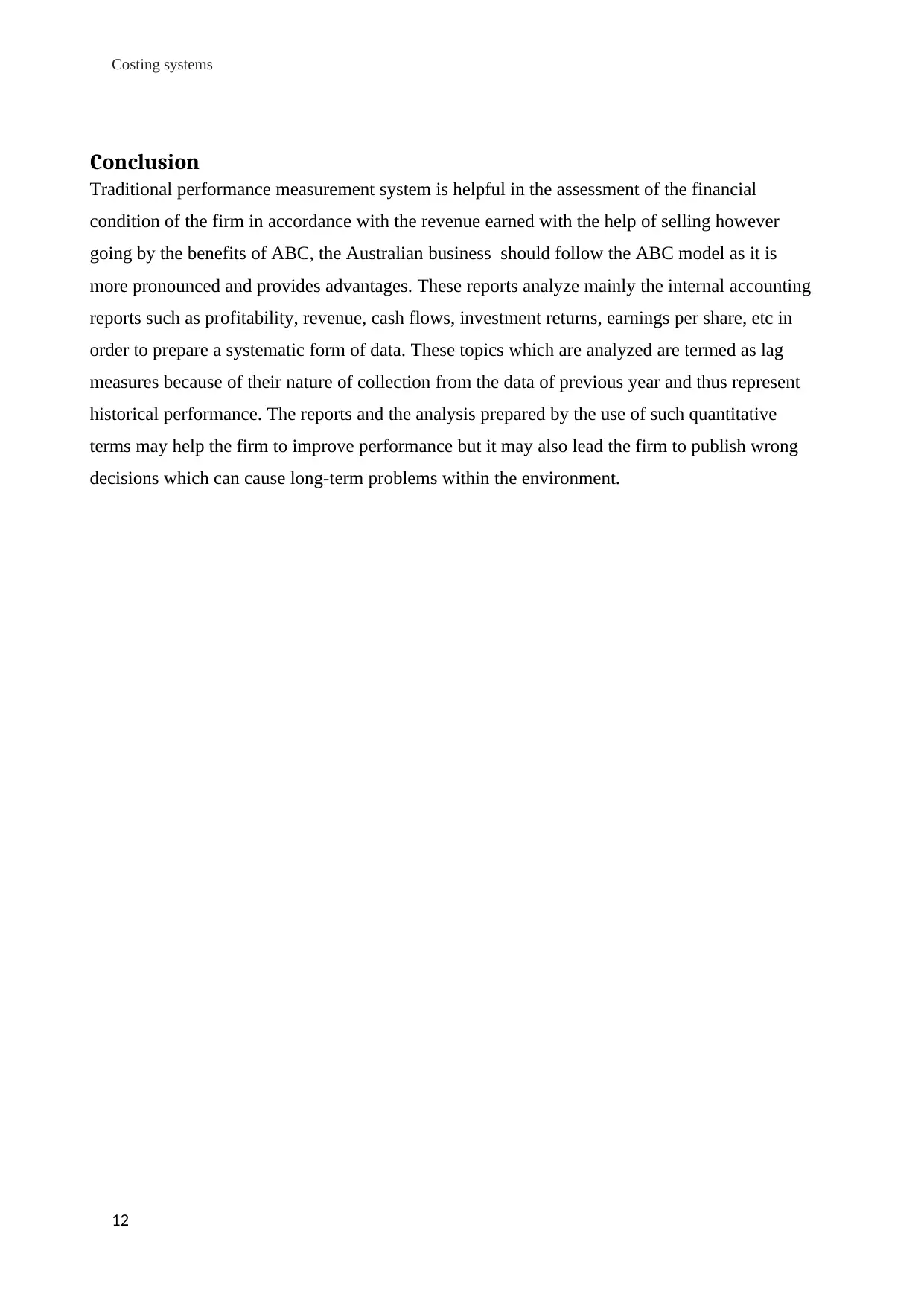
Costing systems
Conclusion
Traditional performance measurement system is helpful in the assessment of the financial
condition of the firm in accordance with the revenue earned with the help of selling however
going by the benefits of ABC, the Australian business should follow the ABC model as it is
more pronounced and provides advantages. These reports analyze mainly the internal accounting
reports such as profitability, revenue, cash flows, investment returns, earnings per share, etc in
order to prepare a systematic form of data. These topics which are analyzed are termed as lag
measures because of their nature of collection from the data of previous year and thus represent
historical performance. The reports and the analysis prepared by the use of such quantitative
terms may help the firm to improve performance but it may also lead the firm to publish wrong
decisions which can cause long-term problems within the environment.
12
Conclusion
Traditional performance measurement system is helpful in the assessment of the financial
condition of the firm in accordance with the revenue earned with the help of selling however
going by the benefits of ABC, the Australian business should follow the ABC model as it is
more pronounced and provides advantages. These reports analyze mainly the internal accounting
reports such as profitability, revenue, cash flows, investment returns, earnings per share, etc in
order to prepare a systematic form of data. These topics which are analyzed are termed as lag
measures because of their nature of collection from the data of previous year and thus represent
historical performance. The reports and the analysis prepared by the use of such quantitative
terms may help the firm to improve performance but it may also lead the firm to publish wrong
decisions which can cause long-term problems within the environment.
12
⊘ This is a preview!⊘
Do you want full access?
Subscribe today to unlock all pages.

Trusted by 1+ million students worldwide
1 out of 14
Related Documents
Your All-in-One AI-Powered Toolkit for Academic Success.
+13062052269
info@desklib.com
Available 24*7 on WhatsApp / Email
![[object Object]](/_next/static/media/star-bottom.7253800d.svg)
Unlock your academic potential
Copyright © 2020–2025 A2Z Services. All Rights Reserved. Developed and managed by ZUCOL.





